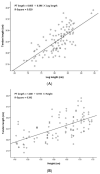Evaluating the Suitability of the Plantaris Tendon for Sports Trauma Reconstruction and a Predictive Model of Tendon Length Based on Height and Leg Length
- PMID: 37959397
- PMCID: PMC10648430
- DOI: 10.3390/jcm12216932
Evaluating the Suitability of the Plantaris Tendon for Sports Trauma Reconstruction and a Predictive Model of Tendon Length Based on Height and Leg Length
Abstract
This study evaluates the suitability of the plantaris tendon (PT) as a tendon graft donor for sports trauma reconstruction and proposes a predictive model for estimating PT length by using an individual's height and leg length. Anatomical dissection of 50 cadavers (32 males and 18 females) yielded precise measurements of PT length and width while also recording height and leg length. Among the lower limbs, 89% were suitable for at least one recommended graft suitability criterion. In addition, PT length exhibited robust positive correlations with height and leg length. Predictive equations were established for estimating the PT length based on leg length and height with consistency across sexes and sides: PT length = 0.605 + 0.396 × leg length (r = 0.721) and PT length = 1.480 + 0.193 × height (r = 0.626). This study underscores the grafting potential of the PT, providing a predictive tool that can aid surgeons in addressing tendon graft challenges within sports trauma scenarios.
Keywords: anatomic reconstruction; cadaver; linear regression; plantaris tendon; sports trauma; tendon graft; tendon length.
Conflict of interest statement
The authors declare no conflict of interest.
Figures




References
-
- Moore K.L., Dalley A.F., Agur A.M. Clinically Oriented Anatomy. 5th ed. Lippincott Williams & Wilkins; Philadelphia, PA, USA: 2006. pp. 648–649.
LinkOut - more resources
Full Text Sources

